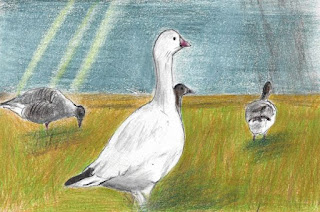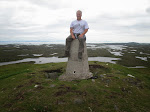Ross’s Goose – Cockerham Marsh, Cockerham, Lancashire, 10th March 2003
During the years either side of the millennium life got very hectic. Albeit it briefly, the oil and gas pipeline phase of my career took me to Lima and Peru in 1998, to San Francisco in California in the United States of America (although the project itself was in the Caspian region of Central Asia) in 2000 and Ankara and Turkey in 2001. There were some projects in-between times closer to home, which was perhaps just as well, as I had got married in July 1997 and my first daughter arrived in October 1998, followed by the second (and last!) in May 2000.
By this time, or certainly once I had a young family, it was evident that I needed to re-invent myself to enable me to work closer to, or indeed, at, home. Something had to give, and indeed, it did. But that’s another story.
Working away, being married, and becoming a father, didn’t leave much time for much else, and birding stagnated, to a large extent.
Thus, in 1996 I had 14 new birds for my British list, and the following year I had 7. However, in 1998 I had none, and only managed 4, 3, 1 and 4 in 1999, 2000, 2001 and 2002 respectively.
Don’t get me wrong, I wouldn’t have had it any other way, and whether or not I was constrained by family life, I still saw some very good birds including Royal Tern and Short-billed Dowitcher in 1999, Eastern Olivaceous Warbler and Long-tailed Shrike in 2000 and Snowy Egret in 2001. Two of the latter three where seen with Ellen, my eldest child along with me.
However, often I had to make do with what was readily available. Thus, when, Gillian, my ex- and our daughters were travelling back from East Lancashire to South Queensferry on Monday the 10th of March 2004, for example, I somehow managed to convince Gillian that a diversion via Cockerham in North Lancashire was a good idea.
There had been a Ross’s Goose in the area for a good while (since the 4th February it would seem). So, even though Ross’s Goose wasn’t a tickable ‘thing’ at the time, the availability of one at Pilling Marsh seemed to me (at least) a suitable investment, as it was a potential armchair tick.
I / we duly saw it, but, given its status at the time, my notes are limited to the very basic facts (date, place, species present..... ). No detailed description was considered necessary, clearly.
So, I’ll not dream up a description of any sort here, other than for the fact that I saw a Ross’s Goose which clearly wasn’t a (Greater or Lesser) Snow Goose. This reminds me of birding in the Central Valley of California when I worked in San Francisco with a birder I had met there. He and I arrived somewhere where there was a huge flock of apparent Snow Geese in front of us, and started going through it, trying to pick out any Ross’s Geese. Very quickly this proved all too easy, and it slowly dawned on us that we were looking at a huge flock of Ross’s Geese and should instead be trying to pick out any Snow Geese……!
Just over a year I after the Pilling Marsh bird I saw another at Vane Farm in April 2004 in the company of Stuart Green ………
Moving swiftly on, when, finally, many years later, on the 29th November 2021, the British Ornithologists’ Union Records Committee announced that it considered there were proven records of Ross’s Goose as a species occurring naturally in its’ own right (rather than just fence-hopping) the Cockerham bird proved to be my first such record.
Specifically, it was accepted as follows:
2003 Lancashire & North Merseyside Eagland Hill, Pilling and Thurnham, 3CY+, 4th February to 17th March; presumed same as 2002 Norfolk.
(C. Holt, P. French and the Rarities Committee, British Birds 112: 622; L. Bacon, P. French and the Rarities Committee, British Birds 117: 671-672).



No comments:
Post a Comment